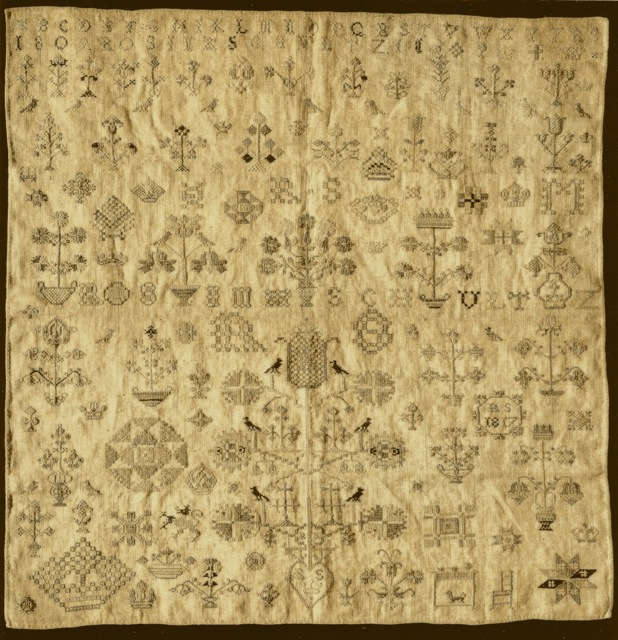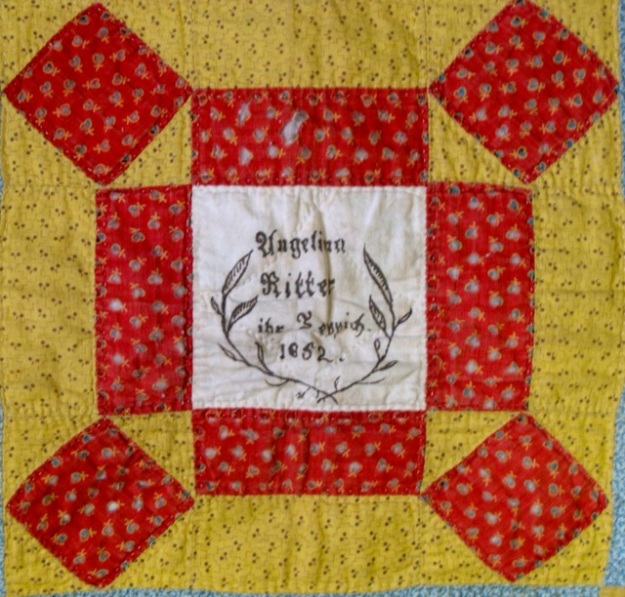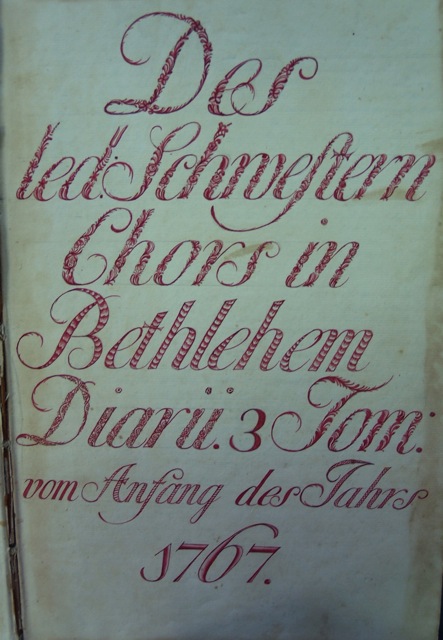Dedication
This blog post is dedicated to Corinne Earnest who left time on May 26, 2016. Without Corinne, Patricia, and Russell Earnest’s unflagging dedication to Fraktur, we would all still be trying to put together many of the pieces of the historical puzzle that they have researched, and solved. She was not zealous for her own purpose, but rather reached out and shared freely her great love and knowledge of Fraktur with everyone. We all shall miss Corinne.
Introduction
The Pennsylvania Dutch and Moravians produced their everyday tools and utensils from seven media: stone, wood, glass, metal, clay, textiles, and paper. Both decorative Fractur script and motifs, as well as everyday cursive calligraphy adorned this material culture, capturing both the spiritual and secular principles then prevalent. In this post we take a look at the scripts and motifs; the practical aspects of time and materials; and how God spoke to the Pennsylvania Dutch and Moravians through the media.
Adam & God
When Adam, father of all mankind, realized his memory wasn’t going to be good enough to remember all the names he had given to earthly living things, he thought he’d better have a talk with God. Now God didn’t want Adam to remember everything, so He said: “Adam, a man can’t keep everything in his head. There should be another way to remember, don’t you think?” Adam, being very relieved, agreed, and so God gave Adam a set of symbols that could be used to keep a record of things. Adam’s children carried on the tradition, and their children’s children, and over time others called these symbols letters or alphabets, and this way of remembering writing.
Writing School in Session
Today, the world over we find varying alphabets, and mankind is still using them to remember. So it was, too, in the eighteenth century when around 1760 people began to ask Johann Michael Schirmer, a writing master, mathematician, and school teacher in the free imperial city of Frankfurt am Main to put together a practical self-instructional handwriting book for the use of young people and adults. Schirmer had very little free time and was reluctant, but finally realized he was the only one who had the broad knowledge and skill necessary to inspire youth to take up the pen and learn to write German in Fraktur, Current, and, chancery scripts, and to notate their Latin, Italian and French in round lettering known as Literae Rotundae and square lettering or Romanae Quadratae. Schirmer’s title page indicates that Current, Canzleÿ, and Fractur are to be understood as German calligraphy, and Cursiva, Rotunda, and Quadrata as Latin calligraphy.
-

-
Fig. I Johann Michael Schirmer. Geöfnete Schreib=Schule oder Deutsche, Lateinische, und Franzöische Vorschriften/Writing School in Session or German, Latin and French Writing Samples. Frankfurt am Maÿn: Selbst Verlag, ca. 1760, Title Page. Courtesy of Winterthur Museum Library Collection of Printed Books and Periodicals, Wilmington, DE, Z43 S33
Current Script
Current, also known as German script, was so named, according to Schirmer, because it was “currently” in common use among the general public. He emphasized that his exercises were so designed to teach one to write in this cursive script with ease and clarity as if one letter grew out of the other.
-

-
Fig. 2 Johann Michael Schirmer. “Von der Current=Schrift überhaupt” or “Concerning Current Script” in Geöfnete Schreib=Schule ….Copperplate 7. Courtesy of Winterthur Museum Library Collection of Printed Books and Periodicals, Wilmington, DE Z43 S33.
Chancery Script
Canzleÿ or chancery script was created from Fractur quite by accident in the chanceries and scriptoria. As shortcuts were found to speed up the making of initial capital letters, first lines, and other applications in Fractur script, rules were altered. Eventually a whole new set of criteria was recognized under the name of chancery script. Schirmer advises the reader that there was no uniform agreement among writing masters concerning this.
-

-
Fig. 3 Johann Michael Schirmer. “Von der Canzleÿ=Schrift überhaupt” or “Concerning
Chancery Script” in Geöfnete Schreib=Schule…. Copperplate 13. Courtesy of Winterthur
Museum Library Collection of Printed Books and Periodicals, Wilmington, DE, Z43 S33.
Fractur Script
Initially German-speaking calligraphers preferred writing in Fractur, but found it required a great deal of time and skill to do so. This made it unsuitable for everyday situations, and, as already mentioned, encouraged simplification in the rules. So it is not surprising that scribes naturally developed a handwriting for daily use, and eventually designated Fractur exclusively for the ornamentation of initial letters, opening text, and important words in documents. Schirmer notes that only after the introduction of the printing press, [1] did people begin referring to the script as Fractur. Although there is no proof of this, one thing is certain: Fractur deriving from the Latin word Fractus, and meaning fractured or broken, certainly was used by those printing or handwriting these angular broken letters, and is still used today to describe its fonts and calligraphy.
-

-
Fig. 4 Johann Michael Schirmer. “Von der Fractur=Schrift überhaupt” or “Concerning Fractur Script” in Geöfnete Schreib=Schule…. Copperplate 21. Courtesy of Winterthur Museum Library Collection of Printed Books and Periodicals, Wilmington, DE, Z43 S33.
Cursiva, Round Letters, Square Capitals
Schirmer categorizes Cursiva, Rotunda, and Quadrata as Latin calligraphy. Quadrata or Square Capitals were tedious to form because of their straight lines and angular configuration, making them more suitable for carving inscriptions on stone with a chisel than for writing a text on parchment or paper with a pen. Calligraphers, therefore, as with Fractur, in the course of time modified the shape of this script to a rounder lettered form that could be written with a flowing connected hand and speed for everyday use, calling it Cursiva. They reserved the Square Capitals for special headings and text on paper, and used them on readily conducive media such as stone or metal.
Intended for cursive handwriting, Schirmer includes large and small Round Letter (Literae Rotundae) alphabets in lower case (Gemeine), as well as decorative upper case (Versalien) examples,. He also introduces Literae Romanae Quadratae (Square Capitals) to be used as ornamental lettering.
-

-
Fig. 5 Johann Michael Schirmer. “Literae Rotundae…Literae Romanae Quadratae” or “Round Letters…Square Capitals” in Geöfnete Schreib=Schule…. Copperplate 27. Courtesy of Winterthur Museum Library Collection of Printed Books and Periodicals, Wilmington, DE, Z43 S33.
Ornamented Letters in Latin and French
For those writing in Latin and French, Schirmer recommends twelve (12) examples in round capital letters to decorate introductory lines.
-

-
Fig. 6 Johann Michael Schirmer. “Anleitung zu gezierten Lateinisch=und Französischen Anfangs=Zeilen” or “How to Decorate Opening Lines Written in Latin and French” in Geöfnete Schreib=Schule…. Copperplate 45. Courtesy of Winterthur Museum Library Collection of Printed Books and Periodicals, Wilmington, DE, Z43 S33.
Ornamented Letters in German
When writing in German, he suggests using any of the following thirty-eight designs in lowercase Fractur to ornament initial text.
-

-
Fig. 7 Johann Michael Schirmer. “Anleitung zu gezierten deutschen Anfangs=Zeilen” or “How to Decorate Opening Lines Written in German” in Geöfnete Schreib=Schule….
Copperplate 46. Courtesy of Winterthur Museum Library Collection of Printed Books and Periodicals, Wilmington, DE, Z43 S33.
“Youth’s Lifelong Obligations” Vorschrift by Johann Michael Schirmer, ca. 1760
Schirmer’s European writing samples are not only exercises to master the various scripts, but are also reminiscent of what we find in similar Pennsylvania Dutch and Moravian Vorschriften in America: a combination of design examples, practice formulas, and moral tips, taken mostly from the Bible, hymns, and religious poems, to keep young and old on the path to heaven. The following text from his “Youth’s Lifelong Obligaions” parallels what we find in American writing samples of the time period:
Focus on your Creator when young, and have Him ever before your eyes and in your heart.
With unfeigned love, childlike diffidence, and total confidence, dedicate the first fruits
of your endeavors to Him. Accustom your lips not to curse or swear, and never be afraid
to use them in prayer, praise, and thanks. Be diligent in learning the Word of God, and live
your life accordingly. Be humble towards everyone, and respect the elderly. Always be willing to oblige your friends and enemies. Avoid hateful words and foolish actions. Shun the temptations of youth, and remain chaste and virtuous. Be steadfast in your work, and eat your bread with dignity. Bann all falsehoods and lies. Harbor no evil thoughts nor associate with bad company. [2]
-

-
Fig. 8 Johann Michael Schirmer. “Lebens Pflichten der Jugend” or “Youth’s Lifelong Obligaions” in Geöfnete Schreib=Schule….Copperplate 40. Courtesy of Winterthur Museum Library Collection of Printed Books and Periodicals, Wilmington, DE, Z43 S33.
“Connoisseurs’ Writing Sample for Reading and Writing” by Wilhelmus Faber, 1812
A comparable American Vorschrift created by Wilhelmus Antonius Faber (active ca. 1790-1820) in 1812 for Johannes Klinger, a school boy living in Exeter Township in Berks County, Pennsylvania, demonstrates not only text similarities, but also mirrors a number of precepts found in Schirmer’s Writing School in Session or German, Latin, and French Writing Samples:
- Firstly, Faber uses Fractur script for the initial lines as suggested by Schirmer, and chooses a double band decorative element similar to Illustration 7 of “How to Decorate Opening Lines Written in German,” (Copperplate No. 46 ) to ornament the opening religious text “Wohl dem den der Herr in…” Just as Schirmer demonstrates the use of calligraphic flourishes in “Youth’s lifelong Obligations,” (Copperplate No. 40), so too we find Faber embellishing not only the initial letter “W” with flourishes, but also, in similar fashion, all along the top of the line.
- The religious text in Fractur script paraphrases the Psalmist David, and then in German script quotes verses 9-11 from Psalm 91, demonstrating the every day cursive handwriting the student is more likely to use throughout his life. The upper and lower case alphabets in Current script are included for practice purposes.
- The final line Johannes Klinger’s Writing Sample, 28th November 1812 is important text identifying the owner, and, accordingly is also done in Fractur.
-

-
Fig. 9 Wilhelmus Faber Vorschrift for Johannes Klinger, 1812. Courtesy of the Henry Stauffer Borneman Collection at the Free Library of Philadelphia, (FLP) frk00359.
Connoisseurs’ Writing Sample for Reading and Writing, 1812
He whom the Savior blesses in his work and household shall prosper. For the Lord is your refuge, and the Most High your deliverance. No evil will befall you, and no plague come nigh unto your dwelling. For He has entrusted you to his angels that they may protect you wherever you may be [Psalm 91:9-11].
A B C D E F G H I K L M N O P Q R S T U V W X Y Z A a | b c d e f fs g h j i k l ll m n o p q r s ss s t u v w x y z tz ch ß sch sl si tz
Johannes Klinger his Writing Sample, Exeter the 28th of November 1812 [3]
Faber was most likely a school teacher, and is best known for his decorative Scherenschnitte or cutwork that frequently encircles the text. However, he also made writing samples such as the FLP example. It has been suggested that he was Moravian since he reputedly once lived in Lititz, Pennsylvania, a Moravian community in northern Lancaster County. He was also, however, active in Berks, Bucks, Chester, Dauphin, Lebanon, Montgomery and Northampton Counties. Knowledgeable in German, Latin, and English, his calligraphy is remarkably fine, and that of a trained scrivener.
A New Definition of Fractur, 1897
In 1897 another meaning of Fractur was introduced that has redefined the way we think of Pennsylvania Dutch and Moravian material culture. In September of that year Henry Chapman Mercer gave a talk The Survival of the Mediaeval Art of Illuminative Writing Among Pennsylvania Germans to American Philosophical Society members in Philadelphia. He suggested that it would be much more convenient if all Pennsylvania German illuminated manuscripts be called Fractur. Since then objects with or without Fractur script can be called Fractur. For example, a bird or flower or geometric design on paper, textiles, clay, wood, glass, metal, or stone with or without any text can be referred to as Fractur. The material culture of both groups, therefore, is represented through visual, as well as written Fractur. Stone and textiles, per Ellen Gehret in This is the Way I Pass My Time, vie with works on paper for containing the most Fractur script, and hand towels are “more verbal than any other form of Pennsylvania German needlework with the exception of samplers.” [4]
“My God, Through the Blood of Christ” Sampler by Elisa Kulp, 1816
Elisa Kulp, a Mennonite living in the Franconia area of Montgomery County Pennsylvania, worked a most extraordinary sampler in 1816. An A B C sampler with square capital letters in the upper half, along with floral and geometric designs in the lower ensured that she would be able to number and mark her linens with her name or initials for inventory, as well as have a template of decorative motifs to embellish other textiles throughout her life. It is worthwhile pointing out that household textiles were highly valued, and an important part of one’s estate.
Elisa embroidered her name in full twice, and also added her initials so that there would be no doubt to whom this lovely piece belonged. She also embroidered two spiritual reminders, both in square capital letters:
- MEIN GOTT ICH BITT | DURCH CHRISTI BLUT | MACHS DOCH MITT | MEINEM ENDE GUT or MY GOD I ASK YOU THROUGH THE BLOOD OF CHRIST TO ASSURE ME A PEACEFUL END.
- O EDEL HERZ BEDENKE DEIN ENDE or O NOBEL HEART CONTEMPLATE YOUR END.
The origin or inspiration of these phrases can be traced to Ämilie Juliane, Imperial Countess of Schwartzburg-Rudolstadt (1637-1706), who was born in 1637 in Barby, a place which in the eighteenth century was to become strongly associated with the Moravians. Like Luther, this noble lady considered prayer and diligence key necessities to one’s life, meditating three times daily. She died in Rudolstadt in 1706. Ämilie Juliane is known to have written over 500 hymns, one of which Die Eile des Lebens or The Hurriedness of Life contains the phrase Elisa cross-stitched “Mein Gott ich bitt durch Christi Blut Machs doch mit meinem Ende gut.” This refrain comes at the end of each of twelve verses, “My God, my God, I ask you through the blood of Christ to assure me a peaceful end.” The beginning of the third verse “Lord, teach me always to contemplate my end,” or “Herr, lehr mich stets mein End gedenken’ may have inspired Elisa to encircle a flowering heart motif in the center of the bottom half of her sampler with the entire command “O Edel Herz Bedenke Dein Ende” or “O Noble Heart, Contemplate your End.” This was a saying near and dear to the Pennsylvania Dutch and appeared frequently on samplers and towels in the abbreviated form OEHBDDE.
“That Which You Want Others to Do” Susanna Steltz Plate by Georg Hübner, 1789
There are two kinds of Pennsylvania Dutch and Moravian redware: the greater majority falls under utilitarian in glazed, unglazed, or partly glazed ware; and a much smaller group of “fancy” glazed and decorated ware. Georg Hübner, a potter in Limerick Township, Montgomery PA made a slip decorated, sgrafitto dish thirteen inches in diameter for Susanna Steltz in 1789 that falls into the latter category. Slipware refers to glazed pieces that have had an element of design added such as a drawing, date, name, or saying. For sgraffito, from the Italian for “scratched,” the slip is painted on the surface and the design is scratched through the slip revealing the contrasting red clay beneath. Although such a piece showed off the potter’s skills, and was less likely to be used daily, there is evidence from marks of wear and tear on some that not all were presentation pieces. The Steltz piece, however, appears to have been rarely used, and does, indeed, demonstrate Hübner’s masterful work.
The potter inscribed the outer rim of the plate in Fractur script with a command Jesus gave to the multitude in his sermon on the Mount found in chapters 5-7 of St. Matthew, and chapter 6 of St. Luke—specifically Matthew 7:12, and Luke 6:31, as well as the date and name of the plate owner: “ March 5th 1789 the plate of Susanna Steltz. All that you would have others do unto you, do unto them.” [5] The inner portion is decorated with a double-headed eagle as per the Fractur script between the two heads: “Portrayed here is a double-headed eagle.” [5] Please note that this is not a Holy Roman Empire double-headed eagle bristling with authority and might, but rather a double-headed eagle of totally different temperament to whom Hübner gave a broad and flowering Pennsylvania Dutch heart.
-

-
Fig. 10 Redware (slip decorated, sgraffito) by Georg Hübner, Limerick Township, Montgomery County, March 5, 1789, Courtesy Winterthur Museum Collection, Wilmington, DE, 965.2301.
“Dear People, Observe” Pennsylvania Stove Plate, 1753
Radiant-heat stoves existed in northern Europe as far back as the mid-sixteenth century. The tradition of casting them in iron with low relief decorative and textual elements, both secular and religious, also originated on the Continent. Some of the eighteenth-century German-speaking immigrants to Pennsylvania brought these cast iron stoves along with them to heat their homes, and when they needed to replace or repair damaged or worn plates, found iron masters who could replicate the traditional plates at local forges.
The Pennsylvania Dutch house in the mid- to late eighteenth century consisted of three rooms on the main floor: a Küche or kitchen on one side of a centrally-located chimney, and a family living space known as the Stube or “room,” as well as the Kammer or “sleeping chamber” on the other. The fireplace opened into the kitchen and, just as in Europe, the most economical way to heat the Stube was via the cast iron five-plate jamb stove, which when put together, formed an open box that could be put against an opening in the wall shared with and opening into the kitchen fireplace. Placing hot coals or burning wood from the fireplace side into the stove opening provided heat in the Stube without the annoyance of smoke.
These plates were made in the same way as in Europe, and typically were adorned with secular or religious inscriptions done in Romanae Quadratae or Capital Square Letters. Fractur visual motifs such as tulips, stars, medallions, wheat sheaves, and human figures often depicted a Biblical story with or without a saying, reminding the viewer of his temporal existence, and need to take stock of the eternal path he was forging.
One unusual stove plate, however, stands apart from all the others, and appears to be a political satire on an event taking place on September 14, 1753. As Henry Chapman Mercer noted in 1914 in his work The Bible in Iron, and as is still the case:
No event on September 14, 1753, either in Pennsylvania, where James Hamilton
(1748-54) was Governor, or in Germany or England, where Frederick the Great
and George the Third reigned, appears to explain this joke or satire (the only
caricature in the whole collection), upon some person, so publicly well known as
to strike the popular fancy and increase the sale of a stove at that time. [6]
This stove plate’s message was easily understood by the denizens of southeastern Pennsylvania in 1753, and although we don’t yet know the true significance of its imagery and text, we can at least contemplate both its visual, and verbal elements.
Two vaulted panels are divided by a vertical molding: At the top on the left in relief are the letters “17.” In the center a rider, in tricorn hat and long coat, clenches a sword in right hand, while holding aloft possibly a torch in his left hand. He conspicuously sits upon a goat. At the top on the right are the letters “53.” In the center a man on foot, wearing a headdress and long coat faces the rider, and with both hands holds a sword in horizontal position in front of him.
Underlined Romanae Quadratae or Square Capital Letters follow:
SEHET. ZU. IHR LIBEN. DEAR PEOPLE, OBSERVE
LEUT. WIE. DER. HERR HOW THE GENTLEMAN
AUFF . DIESEM PFRTE RIDES UPON THIS HORSE.
REIT. D 14 SEPTEMBR THE 14th OF SEPTEMBER
-

-
Fig. 11 “Sehet zu, Ihr liben Leut…” Pennsylvania Stove Plate, ca.1753. Courtesy of
The State Museum of Pennsylvania, Harrisburg, PA, 33.107.3.
“Michael Weber Rests Here in God” Tombstone
“Well over one thousand examples of handcarved decorated gravemarkers exist in Pennsylvania German graveyards with German inscriptions and decorations not unlike those on Fraktur.” [7] The tombstone of Michael Weber, a Revolutionary War veteran, is one of these, and, although the tombstone cutter failed to include any Fractur visual motifs, he chose to inscribe Fractur script, a much more difficult task than if he had used the Square Capital Letters or Romanae Quadratae so suited to stone carving. This marker, unlike many that have been damaged by vandalism, acid rain, and neglect is well cared for and clearly legible: “Michael Weber rests here in God. He was born September 29, 1735 and died December 24, 1826 at age 88 years, 2 months, and 25 days.” [8] As so many others before him, who had used the tools of their trade upon stone, wood, glass, metal, clay, textiles, and paper, this tombstone carver consciously left a lasting warning and promise, one which reaches us even today as we read upon the gravemarker: “O wayfarer, consider your end, which can come all too quickly. Put on Christ Jesus, through whom you can be redeemed.” [8]
-

-
Fig. 12 Michael Weber (1735-1826) Tombstone Fraktur Inscription. Friedensville
Evangelical Lutheran Church Cemetery, Friedensville, PA. Courtesy of AlyssumArts
Endnotes
[1] Johannes Gutenberg introduced the first movable type printing press in Mainz ca. 1440.
[2] “Youth’s Obligations Towards Life,” a translation of Schirmer’s writing sample “Lebens Pflichten der Jugend,” in Geöfnete Schreib=Schule…Franckfurt am Maÿn: Selbstverlag, ca. 1760, copper plate No. 40. For original Fraktur script see Fig. 8. The following is a transcription thereof: Bedenke an deinen Schöpfer | in der Jugend, und habe denselben immer vor Augen | und im Herzen: widme ihm die Erstlinge deiner Kraft, in hertzlicher Lie= | be, kindlicher Furcht und vollkommenem Vertrauen. Bewohne | deinen Mund nicht zum Fluchen und Schwören, und schäme dich | nicht, denselben im Beten, Loben und danken aufzuthun. Lerne fleis= |sig das Wort Gottes, und führe dein Leben darnach [.] Sey demü= | thig gegen jedermann, und ehre die Alten. Befleissige dich der | Dienstfertigkeit gegen Freunde und Feinde. Schandbahre | Wort und Narrentheidung laß ferne von dir seyn. Fliehe die Lüs= | sten der Jugend, und halte dich keusch und züchtig. In deinem Be= | ruf sey fleissig, und esse dein Brod mit Ehren. Verbanne die | Falschheit und Lügen. Hege keine böse Gedanken, und meide | endlich alle böse Gesellschaft.
[3] “He Shall Prosper Whom the Savior Blesses,” a translation of Wilhelmus Faber’s 1812 Johannes Klinger Vorschrift. For original Fractur and German script, see Fig. 9. The following is a transcription thereof: Vorschrift der Liebhabern zum Lesen und Schreiben, 1812. Wohl dem, den der Herr in | seiner Arbe[i]t segnet, und seine Haushaltung beglücket. |[Luther Bibel, 1545; Psalm 91: 9-11] Denn der Herr ist Deine Zuversicht der Höchste ist Dein Zuflucht. Es wird Dir kein |übels [sic] begegnen, und keine Plage wird zu Deiner Hütte sich nahen. Denn er hat seinen [sic] | Engel befohlen über Dir, daß sie Dich behüten auf allen Deinen Wegen.
A B C D E F G H I K L M N O P Q R S T U V W X Y Z A a | b c d e f fs g h j i k l ll m n o p q r s ss s t u v w x y z tz ch ß sch fl fi tz
Johannes Klinger seine Vorschrift, Exeter d 28ten November 1812
[4] Ellen Gehret, This is the Way I Pass My Time: A Book About Pennsylvania German Decorated Hand Towels (Birdsboro, PA: Pennsylvania German Society, 1985), 5.
[5] For original Fractur script, see fig.10. The following is a transcription of the plate rim: “Mertz.5ten 1789 Susanna Steltz, ihre schüssel, Alles was ihr wolt das euch die Leute Duhn sollen Das Duth ihr ihnen.“ Between the two eagle heads, the transcription reads: “Hir ist Abgebilt ein dobelter Adler.”
[6] Henry Chapman Mercer. The Bible in Iron (Doylestown, PA: Bucks County Historical Society, 1961), 59, No. 73, “The Man and the Goat.”
[7] Gehret, 5.
[8] For original Fractur script, see Fig. 12. The following is a transcription of the tombstone: “Hier | ruhet in Gott | Michael Weber | er war gebohren den 29 . | September 1738, und starb | den 24 . December 1826, | in dem Alter von 88 Jahre, | 2 Monate und 25 Tage. | O, Wanders Mann | Gedenk ans Ende. | Das leichtlich kommen kann; | Vielleicht auch gar behende, | Und ziehe Christum Jesum an, durch den man selig werden | kann.
SOURCES
Arthur Cecil Bining. Pennsylvania Iron Manufacture in the Eighteenth Century. Harrisburg: PA Historical Commission, 1938.
“Wilhelmus Antonius Faber” in Russell D. and Corinne P. Earnest, Papers for Birth Dayes: Guide to the Fraktur Artists and Scriveners. East Berlin, Pa.: Russell D. Earnest Associates, 1997, 2nd ed., vol. 1, 264-265.
Wilhelmus Faber’s Johannes Klinger 1812 Vorschift in Henry S. Borneman, Pennsylvania German Illuminated Manuscripts. Norristown, Pa.: Pennsylvania German Society, 1937, published as plate 3.
Ellen Gehret. This is the Way I Pass My Time: A Book About Pennsylvania German Decorated Hand Towels. Birdsboro, PA: Pennsylvania German Society, 1985.
Tandy and Charles Hersh. Samplers of the Pennsylvania Germans. Birdsboro, PA: Pennsylvania German Society, 1991.
Stacy C. Hollander et al., American Radiance: The Ralph Esmerian Gift to the American Folk Art Museum Catalog. New York: Harry N. Abrams, 2001, 141-142, no. 104 [Georg Hübner].
Catherine E. Hutchins., et al. Arts of the Pennsylvania Germans. New York, NY: Published for the Henry Francis du Pont Winterthur Museum by Norton: 1983.
Henry J. Kauffman and Quentin H. Bowers. Early American Andirons and Other Fireplace Accessories. Nashville, Tn: Nelson [1975].
Henry J. Kauffman. American Copper & Brass. [Camden, N.J.]: T. Nelson [1968].
_______________. Early American Ironware: Cast and Wrought. Rutland, Vt.: C.E. Tuttle Co., 1966.
_______________. Pennsylvania Dutch: American Folk Art, New York: Dover Publications, [1964], 94-95 [Georg Hübner].
Henry Chapman Mercer. The Survival of the Mediaeval Art of Illuminative Writing Among Pennsylvania Germans. [Doylestown, Pa: Bucks County Historical Society], [1897].
_______________. The Bible in Iron. Doylestown, PA: Bucks County Historical Society, 1914, 59, No. 73, The Man and the Goat. Google Books, Accessed 22 July 2016 https://books.google.com/books?id=kC9PAAAAYAAJ&printsec=frontcover&source=gbs_ge_summary_r&cad=0#v=onepage&q&f=false
Lisa Minardi. A Colorful Folk: Pennsylvania Germans & the Art of Everyday Life. Winterthur, DE: Henry Francis du Pont Winterthur Museum, Inc., 2015, fig. 20, 22 [Georg Hübner].
_______________. “A Colorful Folk: Pennsylvania Germans And The Art Of Everyday Life,” In Collect Interiors + Collections Online, Fig. 5. Photograph by Winterthur Museum, Garden & Library. Accessed 27 July 2016. https://www.incollect.com/articles/a-colorful-folk-pennsylvania-germans-and-the-art-of-everyday-life
Betty Ring. Girlhood Embroidery: American Samplers and Pictorial Needlework,
1650-1850 . New York: A. A. Knopf, 1993.
Earl F. Robacker. “Pennsylvania Redware,” in Pennsylvania Folklife. Vol. 46, No. 3 (1997), 137-142. Pennsylvania Folklife Magazine. Book 150. Accessed 26 July 2016 http://digitalcommons.ursinus.edu/pafolklifemag/150 [Georg Hübner].
Margaret B. Schiffer. Historical Needlework of Pennsylvania. New York: Scribener, 1968.
Johann Michael Schirmer. Geöfnete Schreib=Schule oder Deutsche, Lateinische, und Franzöische Vorschriften. Frankfurt am Maÿn: Selbst Verlag, ca. 1760.
Peter Steltz Sr., Last Will and Testament, with Codicil, 1832. Wills, Vol 6-7, 1821-1839. Proved and Letters Testamentary Granted to Valentin, Christian, and Peter Steltz Jr.; Author: Montgomery County (Pennsylvania). Register of Wills; Probate Place: Montgomery, Pennsylvania
John J. Stoudt. Pennsylvania German Folk Art: An Interpretation. Allentown, Pa.: Schlecters, 1966, 313 [Georg Hübner].
Stove Plate – Eighteenth Century. Pennsylvania. The State Museum of Pennsylvania. 33.107.3, accessed 9 July 2016 http://statemuseumpa.org/biblical-guidance-cast-iron/
Swan, Susan Burrows. A Winterthur Guide to American Needlework. Winterthur, Del.: Henry Francis du Pont Winterthur Museum, 1976.
_______________. Plain & Fancy: American Women and Their Needlework, 1650–1850. Austin, Texas.: Curious Works Press, 1995.
Marjie Thompson, Kathleen L. Grant and Alan G. Keyser. Forgotten Pennsylvania Textiles of the 18th and 19th Centuries. Cumberland, ME: Linen Press, [2005?].
Daniel Berkeley Updike. Printing Types Their History, Forms, and Use: A Study in Survivals. Cambridge:Massachusetts: The Belknap Press of Harvard University Press, 1962, 2 vols.
Anna Maria Weber, m. n. Angelmayer (6/21/1749-4/3/1834), Friedensville Cemetery, Friedensville, Pa Accessed 10 July 2016 http://www.findagrave.com/cgi-bin/fg.cgi?page=gr&GRid=80302681
Michael Weber (1738-1826), Friedensville Cemetery, Friedensville, Pa.Accessed 10 July 2016 http://www.findagrave.com/cgi-bin/fg.cgi?page=gr&GRid=16462194&ref=acom
Winterthur Research Fellow, Moravian and Pennsylvania Dutch Material Culture, 2016
 Every year Winterthur provides fellowships to a select group of scholars for research
Every year Winterthur provides fellowships to a select group of scholars for research
in their chosen areas of study in social and cultural history, including material culture, architecture, decorative arts, design, consumer culture, garden and landscape studies, Shaker studies, travel and tourism,the Atlantic World, and objects in literature. ~ Winterthur Research Program
Thanks to a short-term research fellowship this summer at Winterthur I have been able to study rare books such as Johann Michael Schirmer’s ca. 1740 Geöfnete Schreibschule in the Winterthur Museum Library Collection of Printed Books and Periodicals; objects in the Winterthur Museum Collection; and manuscripts in the Joseph Downs Collection of Manuscripts and Printed Ephemera. All has contributed to my research for a book in progress Heavenly Fraktur: How Fraktur Influenced Pennsylvania German and Moravian Material Culture. This blog post is based on that research. My sincere thank you to all at Winterthur who have made this fellowship possible.
My thanks also to Donald Trump of the Friedensville Evangelical Lutheran Church; Joanne Kintner and Robert Wood of the Goschenhoppen Historians, Inc.; Patricia Herr, Author and Collector; Dorothy McCoach, Independent Textile Conservator; Janine Pollock and Joseph Shemtov of the Rare Book Department at the Free Library of Philadelphia.
How God Spoke to the Pennsylvania Dutch and Moravians Through the Media Blog Post including transcriptions; translations; and photo images, except for images of the Elisa Kulp 1816 Sampler; the Susanna Steltz Plate; and Sehet zu ihr liben Leut Stove Plate,
© 2016 Del-Louise Moyer.
 Every year Winterthur provides fellowships to a select group of scholars for research
in their chosen areas of study in social and cultural history, including material culture, architecture, decorative arts, design, consumer culture, garden and landscape studies, Shaker studies, travel and tourism, the Atlantic World, and objects in literature. ~ Winterthur Research Program. Thanks to a short-term research fellowship at Winterthur, I have been able to study rare books in the Winterthur Museum Library Collection of Printed Books and Periodicals; objects in the Winterthur Museum Collection; and manuscripts in the Joseph Downs Collection of Manuscripts and Printed Ephemera. All has contributed to my research for a book in progress Heavenly Fraktur: How Fraktur Influenced Pennsylvania German and Moravian Material Culture. This blog post is based on that research. My sincere thank you to all at Winterthur who have made this fellowship possible.
Every year Winterthur provides fellowships to a select group of scholars for research
in their chosen areas of study in social and cultural history, including material culture, architecture, decorative arts, design, consumer culture, garden and landscape studies, Shaker studies, travel and tourism, the Atlantic World, and objects in literature. ~ Winterthur Research Program. Thanks to a short-term research fellowship at Winterthur, I have been able to study rare books in the Winterthur Museum Library Collection of Printed Books and Periodicals; objects in the Winterthur Museum Collection; and manuscripts in the Joseph Downs Collection of Manuscripts and Printed Ephemera. All has contributed to my research for a book in progress Heavenly Fraktur: How Fraktur Influenced Pennsylvania German and Moravian Material Culture. This blog post is based on that research. My sincere thank you to all at Winterthur who have made this fellowship possible.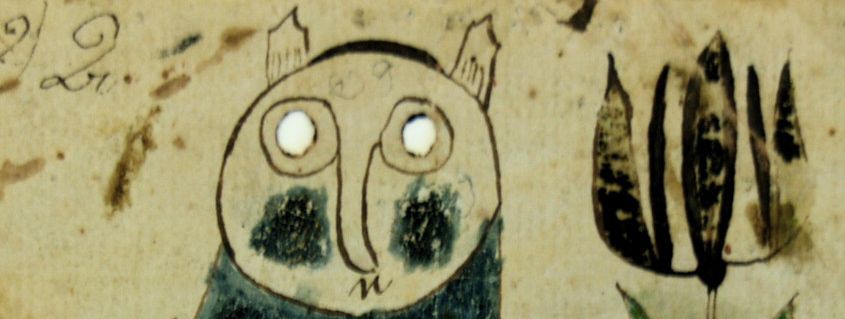
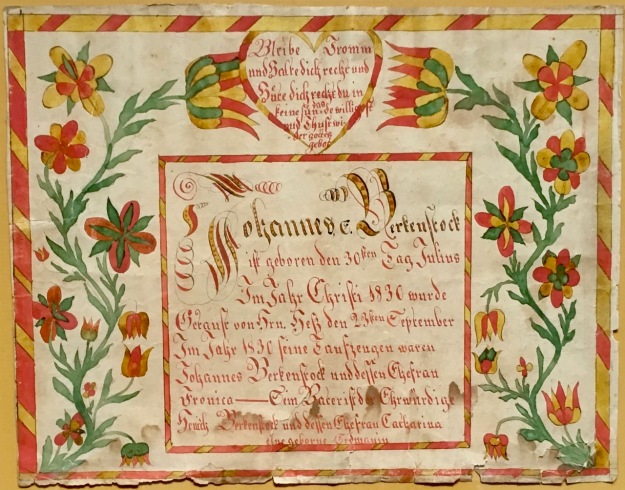

![Fig. 3. John E. Berkenstock Birth & Baptismal Entry [in pencil at bottom]. Church Records for Reformed Church of the Blue Church at Coopersburg, Pa., p. 4. Courtesy, UCC Faith Church, Center Valley, Pa.](https://alyssumarts.files.wordpress.com/2017/01/3_post-15_107-alyssum-blue-church-reformed_p4_-17jan2017_v2_29_image-c2a9-dlmoyer.jpg?w=625&h=207)


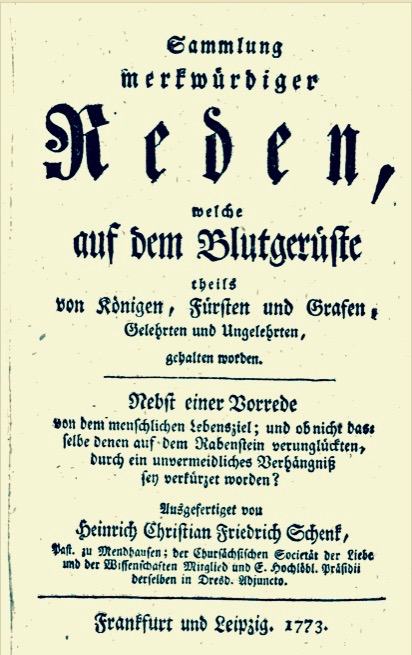





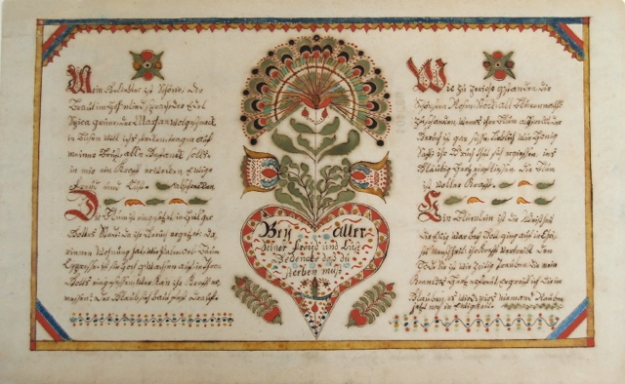
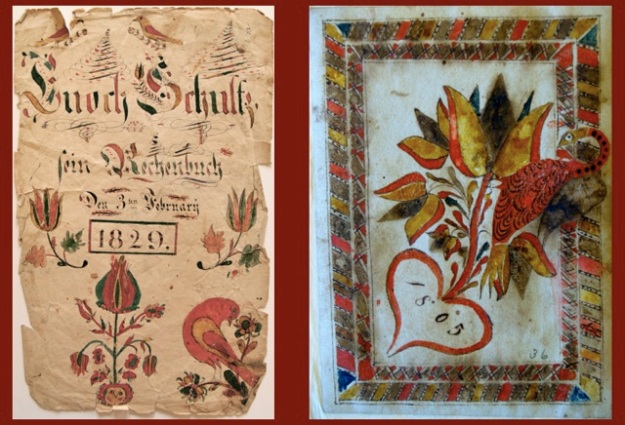

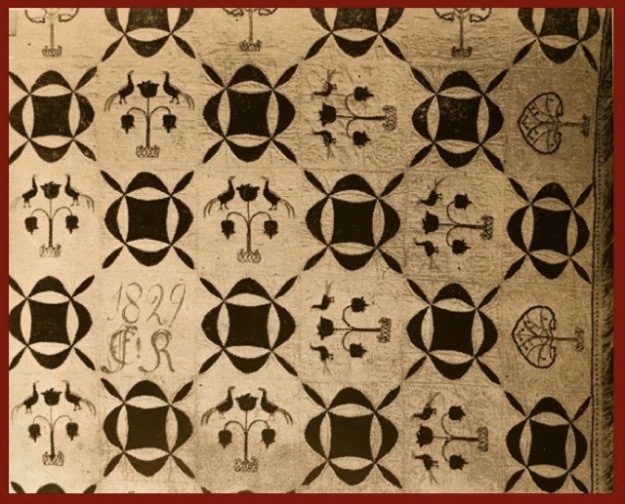
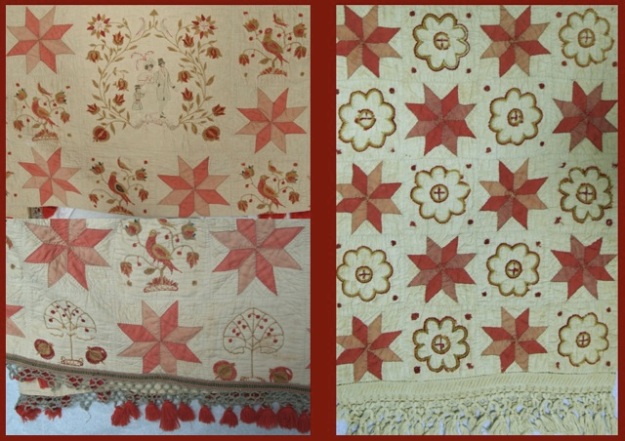

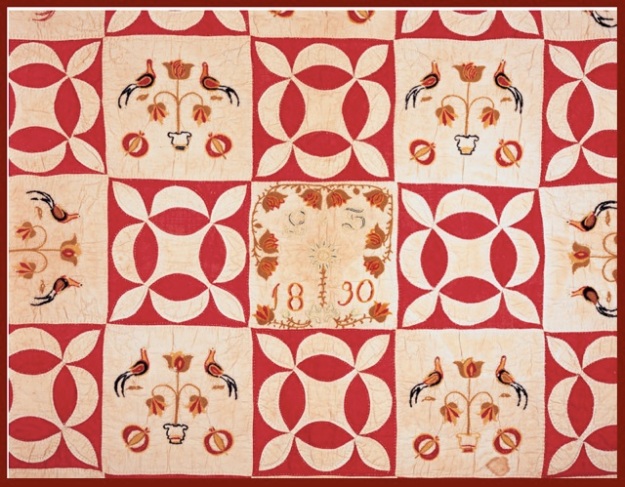
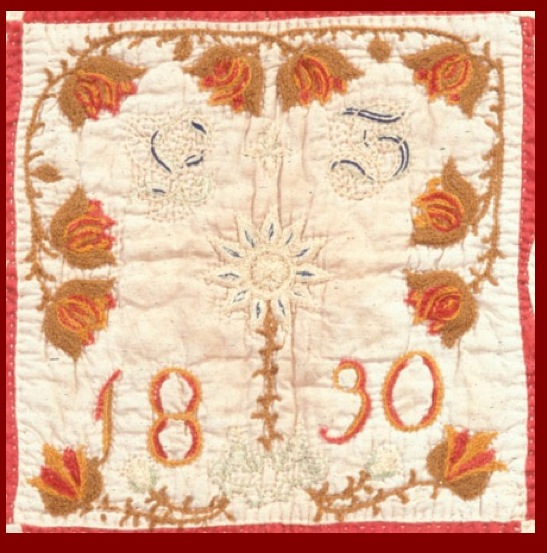
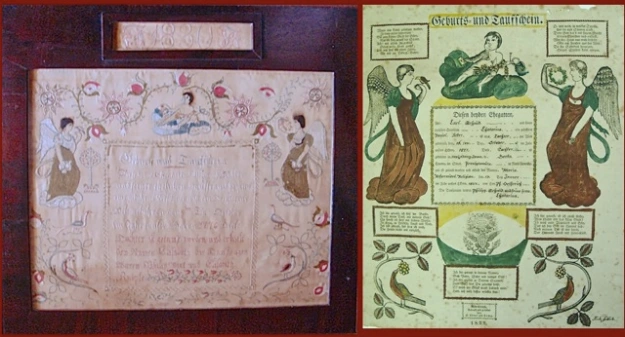

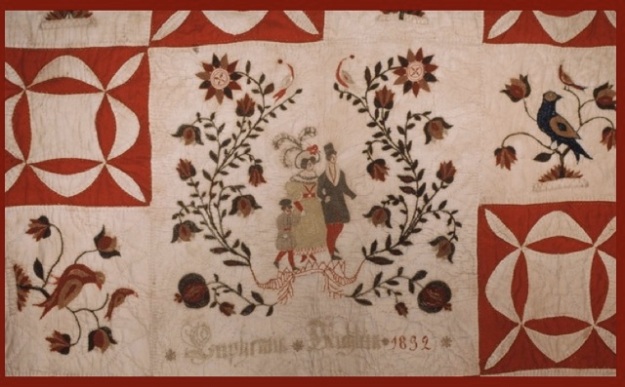
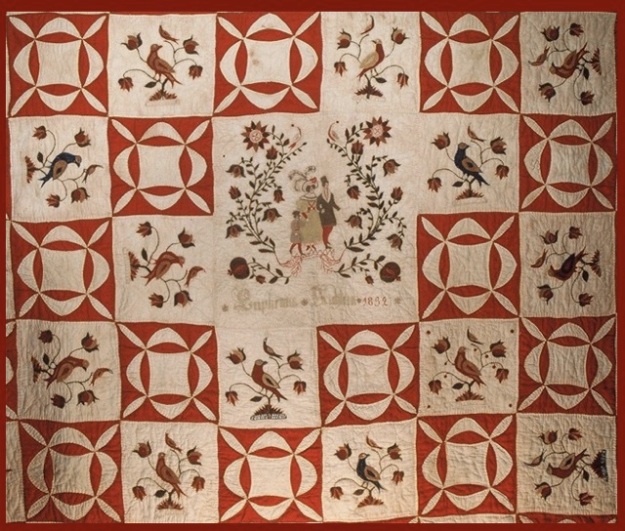




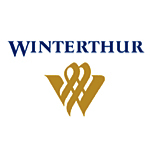















![Fig. 4. Tauf =Zedel from Elisabeth Käster. [Switzerland], 12/22/1811, frk01035. (Courtesy of Borneman Collection at the Free Library of Philadelphia)](https://alyssumarts.files.wordpress.com/2016/05/4_frk01035_taufzedel-from-elisabeth-kacc88ster_2dec1811_flp_181kb_4.jpg?w=625)















